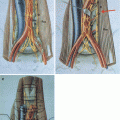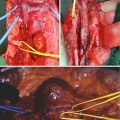Criteria for intermediate-risk patients by IGCCCG criteria
Status
Seminoma
Nonseminoma
Intermediate risk
Nonpulmonary visceral metastases present
AFP 1,000–10,000 ng/mL
Any hCG
hCG 5,000–50,000 mU/mL
Any LDH
LDH 3–10.0 upper limit of normal
Any primary site
Nonpulmonary visceral metastases absent
Gonadal or retroperitoneal primary site
5.2 Clinical Trials Testing Novel Treatment Strategies for Advanced Germ Cell Tumor Exclusively with Intermediate Prognosis
5.2.1 BEP Versus VIP
This trial performed by de Wit and colleagues published in 1998 tested the BEP versus the VIP regimen in 84 GCT patients with intermediate prognosis [2]. The VIP regimen provides another standard for first-line treatment specifically for GCT patients with impaired lung function. After the application of four cycles of chemotherapy, the fraction of complete responses (CR) was similar with 74 % for VIP and 79 % for BEP (p = 0.62), respectively. After a median follow-up of 7.7 years, no differences concerning the relapse rates, disease-free survival (DFS), and OS were detected. The 5-year progression-free survival (PFS) was 85 % (95 % CI 74–96 %) in the VIP arm and 83 % (95 % CI 71–96 %) in the BEP arm. The results demonstrate that the treatment outcome for both regimens has improved compared to the initially presented data by the IGCCCG in 1997. Under VIP, however, the bone marrow function was significantly more impaired. Therefore, with a leak of evidence for its superiority to BEP, VIP is not recommended to be the first choice, but with its equal activity to BEP, it represents a robust alternative for first-line treatment of intermediate-prognosis GCT patients.
5.2.2 Bleomycin, Etoposide, and Cisplatin (BEP) Versus BEP with Paclitaxel (T-BEP)
Two clinical trials by de Wit and colleagues intended to improve the treatment options for intermediate-risk patients by testing the efficacy of an escalated regimen consisting of four cycles of BEP with paclitaxel (T-BEP). Prior to this, paclitaxel had already demonstrated activity in patients with cisplatin-refractory germ cell cancer [3]. Within a phase I/II study published in 1999, the investigators tested the feasibility of the addition of paclitaxel to BEP (T-BEP) with filgrastim (granulocyte colony-stimulating factor) in patients with intermediate- and poor-prognosis GCT. In this trial, 14 patients with intermediate- (n = 7) and poor (n = 7)-prognosis germ cell cancer received treatment, and all of the evaluable patients achieved a complete response [4].
Due to these positive results, a randomized phase II/III study testing T-BEP versus BEP was initiated subsequently by the EORTC for patients with intermediate prognosis. This study was designed to show a 10 % improvement in a 3-year progression-free survival (PFS), but instead of the initially planned 498 patients, only 337 patients were recruited and 7.7 % of the patients were ineligible. A total of 169 patients received BEP and 168 patients received T-BEP. No differences in terms of the PFS after 3 years were seen in the T-BEP group versus the BEP group (p = 0.153). The analysis of all eligible patients, however, demonstrated a 12 % superior 3-year PFS with T-BEP, which was statistically significant (p = 0.03). There were no differences concerning the response rate. In the intent-to-treat analyses, n = 84 patients treated with BEP received complete response, and n = 11 were free of disease after chemotherapy and surgery compared to n = 100 and n = 8 patients treated with T-BEP, respectively (p = 0.1482) [5].
The results of this trial have been discussed very controversially in the community of physicians treating GCT. While the more intense regimen may lead to a reduction of relapses, this does not result in a clear overall survival benefit, most likely due to effective salvage strategies. Thus, T-BEP has not been adapted as a standard regimen for intermediate-risk patients [5].
5.3 Clinical Trials Testing Novel Treatment Strategies for Advanced Germ Cell Tumor Including Intermediate- and Poor-Risk Prognosis Patients
5.3.1 Paclitaxel, Ifosfamide, and Cisplatin (TIP) Efficacy for First-Line Treatment of Patients with Intermediate- or Poor-Risk Germ Cell Tumors
This clinical trial tested the activity of the TIP regimen as first-line treatment of metastatic GCT with intermediate- and poor-risk prognosis with a multicenter phase II study. In total, 44 treatment-naïve intermediate prognosis n = 15 and poor-risk prognosis n = 29 patients received four cycles of TIP consisting of paclitaxel, ifosfamide, and cisplatin, followed by G-CSF and levofloxacin for neutropenic fever prophylaxis. The primary endpoint was the complete response (CR) rate, and secondary endpoints included the PFS and safety. Of the 41 evaluable patients, 28 achieved a CR (57 % of them with intermediate prognosis and 74 % with poor-risk prognosis), and 6 patients achieved a partial response with negative markers (36 % intermediate prognosis and 4 % poor-risk prognosis). With a median follow-up of 2.2 years, the estimated 3-year PFS was 87 % for intermediate-prognosis patients compared to 76 % for poor-risk patients. The 3-year OS reached 98 % (100 % for intermediate prognosis and 97 % for poor-risk prognosis). No treatment-related deaths were reported.
In conclusion, the TIP regimen demonstrated a promising efficacy and was well tolerated [6]. Therefore, a randomized phase II trial to test TIP versus BEP as first-line therapy in patients with intermediate and poor prognosis has been initiated, but results are not yet available (NCT01873326).
5.3.2 Comparing BEP with Alternating Cisplatin/Cyclophosphamide/Doxorubicin and Vinblastine/Bleomycin Regimens
This trial performed by the French Federation of Cancer tested two chemotherapy regimens for intermediate- and poor-risk metastatic nonseminomatous GCT for efficacy and toxicity. From February 1994 to February 2000, 190 patients were randomly assigned on either four cycles of BEP or four to six alternating cycles of CISCA/VB (cyclophosphamide, doxorubicin, cisplatin, vinblastine, and bleomycin). Among the 185 assessable patients (60 patients were of intermediate prognosis), favorable responses did not differ statistically between these two arms. However, the CISCA/VB regimen induced more significant hematologic and mucous toxicities compared with the BEP arm. The 5-year event-free survival rates were 37 and 47 % in the CISCA/VB and BEP arms, respectively (p = 0.15). With a median follow-up of 7.8 years, the 5-year overall survival rates were 59 and 69 % in the CISCA/VB and BEP arms, respectively (p = 0.24). Of the 185 patients, n = 30 and n = 31 intermediate-risk patients received treatment with CISCA/VB and BEP, respectively. There was no difference for the event-free and overall survival for the intermediate-risk patients treated with CISCA/VB versus BEP (p = 0.31 and p = 0.65, respectively). Separate results for the intermediate group were not reported.
This trial represents a study that could not confirm that an alternative multidrug regimen is superior to the standard BEP treatment. Because of equivalent efficacy and lesser toxicity, treatment for patients with intermediate- and poor-risk metastatic nonseminomatous germ cell tumors remained four cycles of BEP [7].
5.3.3 Conventional-Dose Versus High-Dose Chemotherapy and Autologous Stem Cell Transplantation
This clinical trial performed by Motzer and colleagues aimed to investigate the role of high-dose chemotherapy with stem cell support in the first-line treatment of high-risk GCT. Hereby, investigators analyzed previously untreated patients with intermediate- and poor-risk GCT treated with either four cycles of BEP alone or two cycles of BEP followed by two cycles of high-dose chemotherapy (HDCT) containing carboplatin, etoposide, and cyclophosphamide supported with hematopoietic stem cell rescue. Altogether, 219 patients could be randomly assigned with 108 patients (n = 87 poor risk versus 24 intermediate risk) to BEP with HDCT and 111 patients (n = 87 poor risk versus 21 intermediate risk) to BEP alone.
The 1-year durable complete response rate was 52 % after BEP with HDCT and 48 % after BEP alone (p = 0.53). Secondary data analyses investigated the potential relation between tumor marker decline and the outcome. The investigators could demonstrate that patients with slow serum tumor marker decline during the first two cycles of chemotherapy had a shorter PFS and OS compared with patients with a satisfactory marker decline (p = 0.02 and p = 0.03, respectively). Among the 67 patients with unsatisfactory marker decline, the 1-year durable complete response proportion was 61 % for patients who received HDCT versus 34 % for patients receiving BEP alone (p = 0.03). A separate report for the outcome of the intermediate-prognosis patients was not available. The general inclusion of HDCT in first-line treatment for intermediate- and poor-prognosis GCT patients, however, did not improve the treatment outcome. Frequent serum marker determinations to estimate marker decline during the first two cycles of BEP chemotherapy provide a clinically useful estimate of outcome and potentially identify the patients who can benefit from the high-dose chemotherapy approach [8].
Stay updated, free articles. Join our Telegram channel

Full access? Get Clinical Tree






